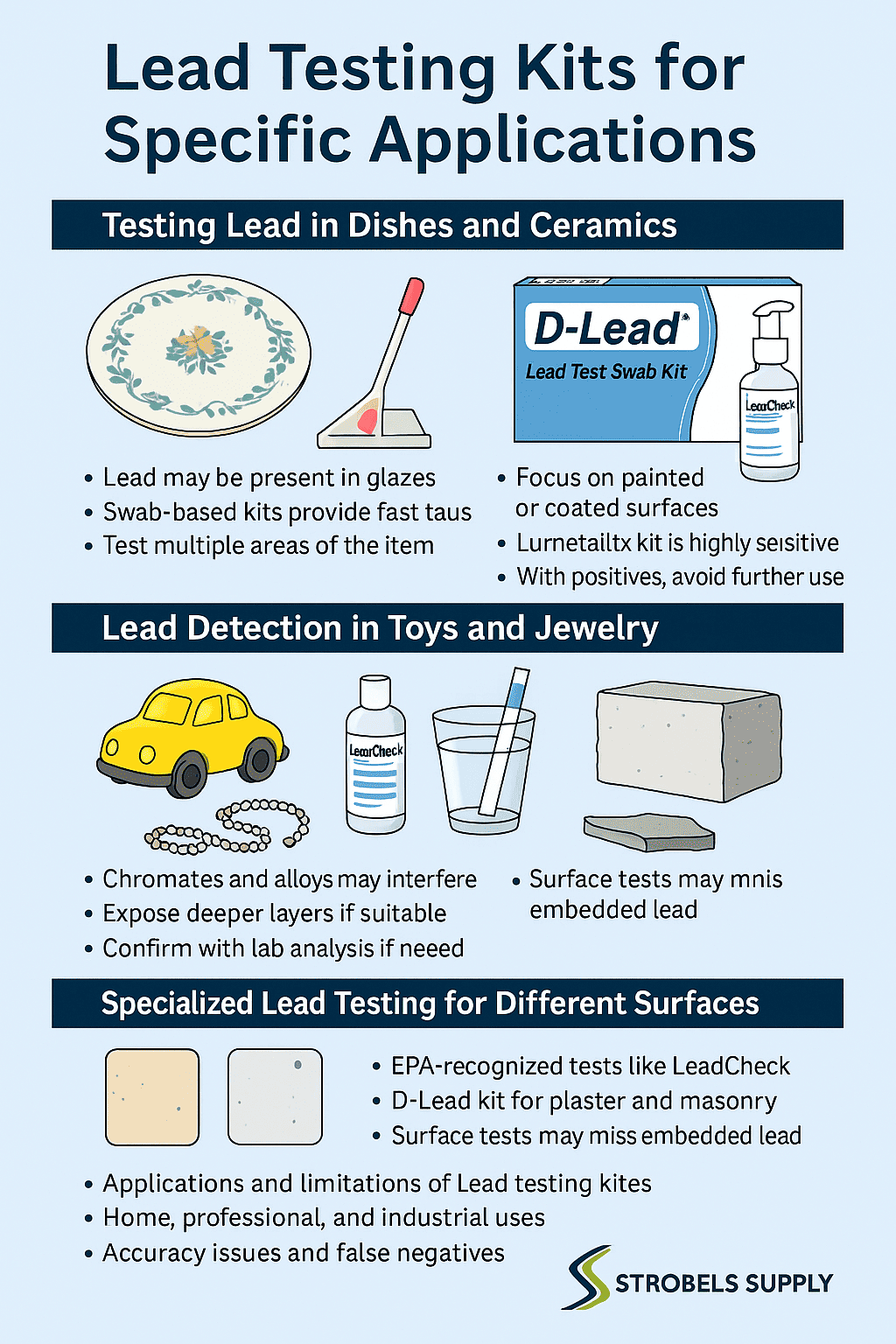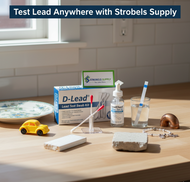Lead Testing Kits Guide: Safe Home and Professional Use
Oct 1st 2025
Lead Testing Kits for Specific Applications
Lead exposure remains a significant concern, especially in older homes, vintage items, and everyday objects such as dishes or children’s toys. While lead is often associated with paint or water, it can appear in unexpected places, posing risks to both children and adults. Whether you are a homeowner checking kitchenware, a parent screening toys, or a professional assessing industrial surfaces, choosing the right lead testing kit is essential.
This guide explains how to use lead testing kits for specific applications—including dishes and ceramics, toys and jewelry, metals and electronics, and varied surfaces. It also covers real-world applications, common limitations, and practical tips for accurate results. Suppliers such as Strobels Supply provide a range of EPA-approved kits to make testing straightforward and reliable.

Why Lead Testing Matters
Lead is toxic and can cause serious health problems. In children, even small amounts may contribute to developmental delays, learning difficulties, and behavioral changes. In adults, exposure has been linked to high blood pressure, kidney issues, and neurological effects.
The U.S. Environmental Protection Agency (EPA) and Occupational Safety and Health Administration (OSHA) highlight common sources of lead exposure: pre-1978 housing, old plumbing systems, and certain imported goods. Lead testing kits are no longer used solely for paint; they now include options for surfaces, consumer goods, and even water analysis.
EPA-recognized kits such as LeadCheck™ and D-Lead® are widely recommended because they meet Renovation, Repair, and Painting (RRP) Rule standards. Still, not all kits are suitable for every surface, making it important to select one designed for the material you need to test.
Testing Lead in Dishes and Ceramics
Ceramic dishes, pottery, and glazed kitchenware can contain lead in surface coatings. Acidic foods like tomatoes or citrus juices increase the risk of leaching.
How it works:
- Clean the surface with a prep wipe (to avoid contamination).
- Rub the swab on the item for about 30 seconds.
- A color change—often pink or red—indicates possible lead.
Best options:
- LeadCheck™ and D-Lead® are EPA-recognized and effective for detecting common lead chromates in colorful glazes.
- Newer UV-based kits, such as Lumetallix, provide higher sensitivity but are generally considered screening tools rather than regulatory tests.
Tip: Test multiple areas, particularly worn spots. Positive results should be confirmed through laboratory testing for food safety.
Lead Detection in Toys and Jewelry
Children’s toys and inexpensive jewelry often contain lead in paints, coatings, or metallic parts. These risks are particularly concerning because of direct contact and the possibility of ingestion.
Testing approach:
- Swab painted surfaces on toys or metallic parts of jewelry.
- Observe color or glow reactions, depending on the kit.
Recommended kits:
- Lead Alert™ has been noted in OSHA evaluations for reliable results on metal surfaces.
- Affordable swab kits are widely available online, though EPA-approved kits are preferable for children’s products.
Limitation: Surface testing only reveals contamination on accessible areas; it cannot measure how much lead might migrate with use.
Lead Test Kits for Metal and Electronics
Metals and electronic components often contain solder or alloys that include lead. This is common in older plumbing, wiring, and circuit boards.
How to test:
- Lightly sand or expose the material’s surface.
- Apply the swab or reagent.
- For bulk metals, specialized sampling tools may be required.
Top kits:
- D-Lead® is EPA-approved for ferrous metals and provides results in minutes.
- For professionals, portable X-ray fluorescence (XRF) analyzers remain the most accurate method, though they are expensive and not designed for home use.
Challenge: Interference from other metals such as tin or antimony can lead to false readings. Laboratory methods like Inductively Coupled Plasma (ICP) analysis provide confirmation.
Specialized Testing for Different Surfaces
Lead can also appear in wood, drywall, plaster, concrete, and brick. Each surface requires a slightly different approach:
- Wood and paint: Swab kits (e.g., LeadCheck™) work well on flat painted surfaces.
- Drywall/plaster: Use kits with sampling tools to reduce contamination risks.
- Concrete/brick: Porous surfaces often require coring for accurate detection.
- Special cases: Structures such as bridges, tanks, or industrial equipment may need professional kits validated under Environmental Technology Verification (ETV) programs.
Testing deeper layers is essential for painted or coated surfaces, since superficial swabbing may not detect underlying lead.
Applications and Limitations of Lead Testing Kits
Common applications:
- Homeowners: Screening paint, water fixtures, or vintage items.
- Professionals: RRP-certified contractors verifying surfaces in pre-1978 buildings.
- Industry: Testing structural coatings or occupational settings.
Limitations:
- Accuracy: False negatives can occur if swabs do not reach contaminated layers.
- Scope: Most kits provide qualitative (yes/no) results rather than precise measurements.
- Shelf life: Reagents degrade over time.
- Surface restrictions: Some pigments or chemical interferences (e.g., sulfates, chromates) may cause false readings.
EPA guidance notes that properly used, EPA-recognized kits reliably identify negative results. However, positive or inconclusive outcomes should always be confirmed by laboratory testing.
Choosing the Right Kit
Lead testing kits are a practical first step in reducing exposure risks across a wide range of applications. They are quick, affordable, and easy to use, making them suitable for households, schools, and workplaces.
For initial screening, EPA-approved kits like D-Lead® and LeadCheck™ are recommended. For regulatory compliance or high-risk environments, laboratory testing remains the gold standard.
Suppliers such as Strobels Supply offer EPA-approved kits with clear instructions and fast delivery, providing accessible solutions for both homeowners and professionals.
Disclaimer
Always follow the manufacturer’s instructions. This guide is for informational purposes only, based on public data from the EPA and OSHA. For remediation or regulatory compliance, consult qualified professionals.
Frequently Asked Questions
What Are the Different Types of Lead Test Kits?
Lead test kits vary by application, ensuring you can screen specific surfaces or materials:
- Swab Kits (e.g., LeadCheck™, D-Lead®): Detect lead in paint, ceramics, toys, or jewelry with a quick swab (30 seconds to minutes). A pink/red color signals lead presence. Ideal for home use but not conclusive for absence.
- UV/Fluorescence Kits (e.g., Lumetallix): Ultra-sensitive for metals, plastics, or electronics, detecting lead at nanogram levels via UV glow—perfect for non-destructive testing.
- Water Test Kits: Strips or vials measure dissolved lead in drinking water (4-10 PPB detection) in 5-10 minutes, great for plumbing checks.
- Professional Kits: For industrial surfaces like concrete or brick, these include sampling tools for lab submission, ensuring precise results.
Tip: A positive result indicates lead (or interference); a negative isn’t definitive. For critical cases, confirm with a lab. Browse our lead testing kits for the right fit, like our $33.27 swab kits for toys or dishes.
What are the EPA Recommended Lead Test Kits?
The EPA recognizes three lead test kits for Renovation, Repair, and Painting (RRP) Rule compliance:
- Luxfer Magtech LeadCheck™: Tests wood, drywall, plaster, ferrous metal.
- D-Lead® (ESCA Tech, Inc.): Tests wood, drywall, plaster, ferrous metal.
- State of Massachusetts Kit: Tests drywall, plaster.
These kits meet the negative response criterion (1.0 mg/cm² or 0.5% by weight) for listed substrates. They cannot be used on unlisted surfaces like stucco or non-ferrous metals for RRP compliance. Source: EPA, Jan 2025.

Bar Chart of EPA-Recognized Kits Substrates Compatibility
Do lead test kits really work?
Yes, lead test kits work effectively as screening tools. EPA-recognized kits like LeadCheck™ and D-Lead® can reliably identify negative results on approved surfaces such as painted wood, drywall, plaster, and ferrous metals. However, they may not detect lead beneath multiple paint layers or in very low concentrations. For definitive results, confirm positives or inconclusive tests with laboratory analysis or XRF (X-ray fluorescence).
What is the gold standard for lead testing?
The “gold standard” for lead testing depends on what you’re testing:
- For surfaces and materials: laboratory methods such as ICP-MS (Inductively Coupled Plasma Mass Spectrometry) or Atomic Absorption Spectroscopy (AAS).
- For on-site screening: XRF analyzers used by certified professionals.
- For human exposure: a venous blood lead test conducted in a medical setting.
Where can I get lead test kits?
Lead test kits are available from:
- EPA-recognized kit suppliers: LeadCheck™, D-Lead®, Massachusetts Kit.
- Home improvement retailers: 3M, Strobel Supply, Amazon.
Are Free Lead Testing Kits Available?
Some state programs (e.g., Wisconsin DHS, HUD’s Lead Hazard Control) provide free kits for paint or water testing, especially for pre-1978 homes or low-income families. Search “free lead testing kits near me” to find local resources. If unavailable, our affordable kits from $33.27 at Strobels Supply ensure reliable screening for toys, dishes, or water.
How Do I Use a Lead Testing Kit Properly?
Paint/Surfaces: Sand to expose paint layers, activate swab, rub for 30 seconds, and check for pink/red. Test multiple areas. Confirm positives with XRF or lab.
Water: Collect a first-draw sample, dip the strip, wait ~8 minutes, and compare to the color chart. Retest positives at a lab.
Toys/Jewelry: Use swabs or UV kits, following timing instructions. Avoid scratching delicate surfaces.
Tip: Wear gloves and read kit manuals.
When Should I Call a Professional for Lead Testing?
Hire a certified lead inspector or lab for:
- Renovations in pre-1978 homes (RRP Rule compliance).
- Positive or unclear kit results needing verification.
- Legal documentation (e.g., real estate, OSHA compliance).
- Complex surfaces like electronics or concrete requiring XRF/lab analysis.
Example: If a kit shows lead in jewelry, confirm with a lab. Our kits screen effectively, but pros ensure accuracy.

 US Dollars
US Dollars
